
|
Sale 98
The Pre-Long Beach Auction June 4-7, 2017
| Ancient Judaean - Art, Judaica & Antiquities |
| |
| |
| Lot |
Photo |
Description |
Realized |
Lot 2000 |
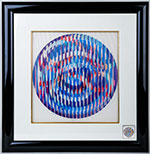 |
Agam, Yaacov. Yaacov Agam (1928) Extremely popular artist lives in New York, Israel and France. Agam is known for religious and environmental themed sculpture, kinetic and optical art. Offered here is a signed example of his lenticular (agamorph) work from his Mission of Peace series, numbered 19/25 H. C. Piece measures 15 x 14" and is handsomely framed to 24½ x 24". Also, this piece boasts in the lower right corner set within the mat the French postal stamp from 1980 which has the very image of the piece being offered. Estimate Value $800 - 1,000
View details and enlarged photo
| Realized
$480 |
Lot 2001 |
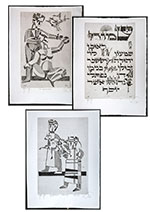 |
Krol, Abram, The Torah, The 5 Books of Moses Set; 187 Signed Artist's Proof Engragivings. Abram Krol. (1919-2001) The Torah. Rare full set of Abram Krol's signed proofs for his magnum opus, the illustrations of the Five Books of Moses (Suite de 187 bruins pour La Pentateuque). The set is comprised of 187 Abram Krol signed engravings, each marked and approved as artist's proofs of his illustrations of the The Pentateuch.
All are 12" x 8", titled and signed by Krol in pencil:
Genesis, 50 plates
Exodus 40 plates
Leviticus, 27 plates
Numbers, 36 plates
Deuteronomy, 34 plates
The set is complete. The first edition carried 187 plates; a 1993 edition (Paris), 189. This is the 1967 edition. Other editions have appeared in Haifa (1969) and Troyes (1988).
As of this writing, we know of only two full sets: this one, and the one at the Library of Congress, which was a gift of the artist. This set is deemed superior to the set in the Library of Congress, because each engraving bears Krol's approval - "épreuve graveur," in the lower left corner, whereas the Library's set is merely numbered. Estimate Value $6,000 - 8,000
View details and enlarged photo
| Unsold |
Lot 2002 |
 |
Picard, Bernard (1673-1733). Parisian-born designer and engraver known for his work on Biblical topics, notably his series on the "Cermonies des Juifs". Here we offer a pair of engravings -- regular and retrograde -- entitled "Les Juifs presentant le Pentateuque au Pape dans the Collisée" or "The Jews presenting the Pentateuch to the Pope in the Colliseum", dated 1725. In very good to fine condition. Size: 4¼ x 4½". Matted and framed to 13 x 8¼". Estimate Value $150 - 200
Ex Living Torah Museum collection.
View details and enlarged photo
| Realized
$96 |
Lot 2003 |
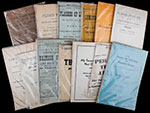 |
Collection of Early Zionist Publications. Lot of 13 Zionist pamphlets, including: "Why is the Jew Persecuted Today?" by Leo Kaul; "Identifications of the English Nation with Lost Israel: England's Coming Glories," "Forty-Seven Identifications of the British Nation with the Lost House of Israel," and "Oxford Wrong in Objecting to the English Being Identical with Israel," all by Edward Hine; "The Forgeries and Falsifications in the Antisemitic Literature," by Shlomo Gluecksmann; "Perish the Jew: The Inside Story of the Jewish Situation in Germany," by Edgar Ansell Mowrer; "My Second Visit to Nazi Germany," by Ferdinand M. Isserman; "Problems of the Jews in the Contemporary World," by Charles E. Shulman; and "Why Jews are Persecuted," by John H. Dietrich. A fascinating assemblage representing a distinct historical moment. Condition ranges from good to fine. Estimate Value $300 - UP
View details and enlarged photo
| Unsold |
Lot 2005 |
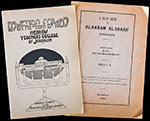 |
Two Early Zionist Publications. Lot includes two early publications.
1. "A Brief Guide to Al-Haram Al-Sharif Jerusalem", published by the Supreme Moslem Council, Jerusalem, 1925. Very good
2. "Hebrew Teachers' College of Jerusalem", published by the American Committee of the Hebrew Teachers' College of Jerusalem, New York, 1925. Fine. Estimate Value $100 - 150
View details and enlarged photo
| Unsold |
Lot 2006 |
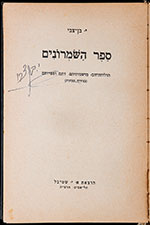 |
Ben-Zvi, Yitzhak (1884-1963). The 2nd and longest living President of Israel. Here we offer a signed copy of the book titled Sefer Hashomronim, autographed in Hebrew on the title page by the late Israeli Prime Minister. Hardcover, octavo, 268 pp. The book concerns the Samaritans, an ethnoreligious group living in the Levant. In terms of their faith, the Samaritans practice Samaritanism, an Abrahamic religion closely related to Judaism. Based on the Samaritan Torah, Samaritans claim that their worship is the true religion of ancient Israel prior to the Babylonian Exile, preserved by those who remained in the Holy Land, as opposed to Judaism, which they assert is the amended religion that returned to Israel along with those once in exile. Estimate Value $100 - 150
View details and enlarged photos
| Unsold |
Lot 2007 |
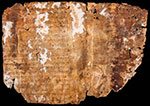 |
12th Century, Handwritten Leaf of the Talmud. Handwritten on vellum, this page of the Talmud predates publication of the first complete edition of the Talmud in 1540 by Daniel Bomberg. Bomberg employed rabbis, scholars, and apostates at his Venetian publishing house, and was responsible for the first Rabbinic Bible, as well as the first complete Babylonian and Jerusalem Talmuds. It was once customary for Jews to use old manuscripts as binding material for their newly printed and bound books. This piece is an example of that practice. Fragile, with moderate toning throughout and rough edges. Approximately 11 x 8". Partially restored. Estimate Value $150 - 200
Ex Living Torah Museum collection.
View details and enlarged photos
| Realized
$276 |
Lot 2008 |
 |
14th Century Torah Manuscript Leaf. Handwritten on vellum, this page of the Talmud predates publication of the first complete edition of the Talmud in 1540 by Daniel Bomberg. Bomberg employed rabbis, scholars, and apostates at his Venetian publishing house, and was responsible for the first Rabbinic Bible, as well as the first complete Babylonian and Jerusalem Talmuds. It was once customary for Jews to use old manuscripts as binding material for their newly printed and bound books. This piece is an example of that practice. With some toning around the perimeter, but still a handsome exemplar and in very good condition. Size: 5¼ x 7¾". Estimate Value $150 - 200
Ex Living Torah Museum collection.
View details and enlarged photo
| Realized
$276 |
Lot 2009 |
 |
Ben-Gurion, David (1886-1973). Primary founder and first Prime Minister of the State of Israel. Autograph letter signed, in Hebrew, on lined notepaper, one page, 4½ x 8½", August 25, 1965. To Rabbi Dr. Zvi Harkavy, Librarian of the Chief Rabbis of Israel's Library, known as Hichel Schlomo. Accompanied by the original envelope. The letter addresses Harkavy's activities on behalf of Russian Jewry, and states that Ben-Gurion has no updates from a meeting held in Paris. With a few stains from paper clips at the top and bottom, and some creasing and chipping at the corners, the text of the note remains clear, as does the signature. In very good condition. Estimate Value $500 - 600
View details and enlarged photo
| Unsold |
Lot 2010 |
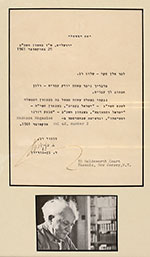 |
Ben-Gurion, David (1886-1973). Primary founder and first Prime Minister of the State of Israel. Typed letter signed, in Hebrew, as Prime Minister, on official letterhead with the raised seal of the Israeli government, 1 page, 8 x 6", Jerusalem, Israel, October 25, 1961. To Mr. Allen Secher. Accompanied by the original mailing envelope. Commenting first on the addressee's apparent facility with the Hebrew language, Ben-Gurion writes a straightforward response, providing reference to a number of published articles concerning the unmentioned topic about which Mr. Secher inquired. The letter is framed with a small black & white photograph of Ben-Gurion for an overall size of 15 x 12". Folded at the vertical and horizontal centers to fit the envelope, else fine. Estimate Value $1,500 - 2,000
View details and enlarged photo
| Unsold |
Lot 2011 |
 |
Grand Lodge, Independent Order Free Sons of Judah Benificiary Certificates, 1905. Very rare pair of vintage original death benefit certificates as issued to members of the Grand Lodge of the Independent Order Free Sons of Judah organized in 1849. Husband and wife, Albert and Julia Mezey were each issued a certificate for moneys to be disbursed at the time of their deaths not to exceed $500, a privilige they enjoyed being members of James A. Garfield Lodge No. 51. in New York. Certificates are beautifully hand lettered with their names, lodge and date, June 18, 1905 and signed by the Grand Secretary and Grand Master. Certificates measure 14" x 17" and while orginally folded, have been archived flat for so long that the fold lines are faint and in no way detract from the overall appearance. We have not seen examples of these certificates come to auction. Estimate Value $300 - 400
View details and enlarged photo
| Unsold |
Lot 2012 |
 |
Herzl, Theodore - Rare Autograph Letter Signed, Three Months Before His Death (1860-1904) Austro-Hungarian Jew who was the founder of modern Zioniam; writer and editor. Rare Autograph Letter Signed ("Th Herzl") as editor of the influencial paper, Neue Freie Presse, one page, 9 x 5¾", on business letterhead, Vienna, March 29, 1904. Written in German to an unidentified baroness about the publication of one of her articles: "Both writings are interesting and full of talent - but unfortunately not suited to our paper. I hope that you can once again hit the right tone for us. Respectfully Th Herzl." Boldly penned and signed. Light toning, a couple of small, closed edge tears, and an ink smudge in the "l" of "Herzl." A penciled notation on the verso of the integral leaf, "Meran-Obermais, Villa Ubensheim," may identify the recipient. Very few Herzl autograph letters signed have appeared at auction. At the time of this letter, Herzl was ill and overworked. He would die just over three months later (July 3), at the age of 44. Before his death, he asked that his remains be moved to Jerusalem when the nation was formed in Palestine; he now rests on the peak of Mt. Herzl.
Herzl had a long-standing relationship with The New Free Press. It provided financial support, and he remained its literary editor until his death. He had accepted a post as a writer with the prestigious paper in 1892, after receiving a Doctorate of Laws in 1882 from the University of Vienna and failing in his efforts as a playwright. The turning point in his life would be his coverage of the Dreyfus trial in Paris. Captain Alfred Dreyfus, who was accused of spying for Germany, was the only Jewish member of the French Army General Staff. After considering the evidence, or lack thereof, Herzl became convinced that being Jewish was Dreyfus' only crime. From that point on, Herzl worked fervently to convince other Jews that they needed their own independent state. In 1896, he wrote Der Judenstaat, setting forth the idea that Jews could only be safe in a nation in which Jews were the majority, and explaining in detail how the nation would function. The publication of this 65-page manuscript was a "Eureka" moment for many Jews and Herzl, who worked tirelessly toward his goal until his death, became a legend. Estimate Value $3,000 - 5,000
View details and enlarged photo
| Unsold |
Lot 2013 |
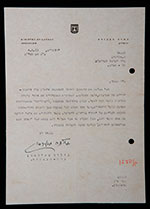 |
Meir, Golda - Great TLS With Message to Soviet Jews: "thank you for having remained Jews" (1898-1978) Israeli stateswoman and fourth prime minister (1969-1974). Brought up in Milwaukee, WI, she emigrated to a kibbutz in Palestine in 1921 and became a leading figure in the Labor movement. She went to become the Israeli ambassador to the Soviet Union (1948-9), the minister of labor and foreign minister. As prime minister she encouraged the emigration of thousands of Soviet Jews to Israel, and strengthened relations with the United States.
Typed letter signed "Golda Mayerson" in Hebrew, as Minister of Labor, one page, 8¾ x 6¼", on official letterhead, Jerusalem, August 4, 1953. With English translation. Five months after the death of Joseph Stalin (on March 5th), during the power struggle to succeed him (Khrushev was named First Secretary of the Communist Party of the Soviet Union on September 14, 1953), Meir writes to S[hmuel] Eliashiv, the Israeli Minister to the Soviet Union: "I understand your feeling in returning to Moscow and to a vast land of suspicion, hostility and silence. You have undoubtedly received instructions as to what to say, and how to say it, to the government functions there. True, 'liberalism' is indicated by the new leadership towards the Jews, one important thing I ask that you demand repeatedly: the right of Soviet Jews to emigrate to Israel. In respect to the Jews I don't know what you will say to them, I know what I said to them in my mother tongue, 'thank you for having remained Jews.' Have a good trip and success in your duty."
Two punch holes, red pencil notation, and one tiny edge tear in right margin, else fine. Estimate Value $800 - 1,000
View details and enlarged photo
| Unsold |
Lot 2014 |
 |
Early Israelite Antiquity Display. Housed in a clear plastic hanging third demensional frame with mirror back are the following:
1. Baylonian lapis lazuli duck weight. 2. Two Egyptian bronze animal weights: 1 Kedet (10.6 g) and 2 Kedet (18.0 g). 3. Judean 1st Temple Period stone 4 shekel weight (40.4 g) with inscription. 4. Two Israelite early bronze "Bracelet Money" ingots (among the earliest attempts at money). 5. Roman Period, 2 child bronze rings, one with an inscribed "Shin". 6. Roman 2nd century terracotta oil lamp.
Total of 9 items in display case. Estimate Value $1,000 - UP
The Brody Family Collection; Ex Superior's May 30, 1995 Sale, lot 8159.
View details and enlarged photo
| Realized
$1,860 |
Lot 2015 |
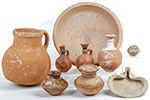 |
Donald Brown Collection of Nine Artifacts Excavated at Lachish, Israel. Circa 830-586 BC. Dr. Donald Brown excavated the Biblical city of Lachish under the direction of Dr. James Lee Starkey from 1932-1938. At age 43, Starkey's career ended tragically when he was murdered en route to deliver a lecture in Israel. Some of the most fascinating finds from Lachish are now in the collections of the British Museum and the Israel Museum. After reading an article in Biblical Archaeology Review about the Living Torah Museum in 2004, Dr. Brown donated a collection of antiquities that he had excavated at Lachish, in addition to a selection of items he excavated in Egypt in the 1920s.
This nine-piece collection includes a series of eight clay vessels -- three delicately formed and painted unguentaria, two modestly sized, painted vases, a more coarsely fabricated terracotta patera, a large shallow bowl, and large, simply formed pitcher -- and a single stone spindle whorl. Some are chipped and/or show signs of repair, but the collection remains handsome and historically significant. Estimate Value $500 - UP
Ex Living Torah Museum collection; ex Donald Brown private collection.
View details and enlarged photo
| Realized
$930 |
Lot 2016 |
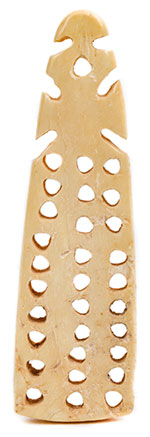 |
Israelite Period, Circa 800-600 BC. Small Bone Calendar or Game Board. This long, slender artifact is delicately carved at its narrowed tip, and perforated by three columns of ten holes each along its length. Intact, and in very good condition. Length: 2 3/8". Estimate Value $400 - 500
Ex Living Torah Museum collection; Ex Archaeological Center Auction No. 45, lot 329.
View details and enlarged photo
| Realized
$240 |
Lot 2017 |
 |
Israelite Period, Ca. 800-600 BC Bone Calendar or Game Board. This carefully fashioned item, smooth on one face and carved on the other with a raised border surrounding a nearly scaled interior perforated with two columns of holes, appears broken at one end. Width: 1 1/8"; Length: 4¼". Estimate Value $300 - 400
Ex Living Torah Museum collection.
View details and enlarged photo
| Unsold |
Lot 2018 |
 |
Sumerian, ca. 3000 BC Marble Stamp Seal. The oval-shaped hardstone marble seal bears six circular hollows to form a simple rosette. The convex upper portion of the object is perforated to be worn as a pendant. In excellent condition. Length: 1"; Width: 7/8". Estimate Value $300 - 400
Ex Living Torah Museum collection; ex David Liebert estate.
View details and enlarged photos
| Unsold |
Lot 2019 |
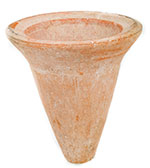 |
Israelite Period Terracotta Funnel. Cone-shaped terracotta funnel. Well-preserved, with just a few minor chips at the top and bottom. Height: 7½"; Diameter: 7". We note a partial export stamp from the Israel Antiquities Department. Estimate Value $250 - 300
Ex Living Torah Museum collection.
View details and enlarged photo
| Unsold |
Lot 2020 |
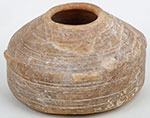 |
Egypto-Roman, Ca. 1st Millenium BC., Alabaster Vessel. Vessel with circular base, low body, and shoulder tapering sharply to a narrow circular mouth and slightly rounded rim. Four raised handles are evenly spaced around the juncture of the body and the shoulder. Concentric circles are incised over the surface, from the base to the mouth. Intact with repairs. Height: 2¼"; Diameter: 3�". Estimate Value $300 - 400
Ex Living Torah Museum collection.
View details and enlarged photo
| Realized
$180 |
Lot 2021 |
 |
Egyptian Alabaster Toy Boat. Tiny hand-carved boat of uncertain origin, with distinctively shaped hull. Intact. Length: 50 mm. Estimate Value $150 - 200
Ex Living Torah Museum collection.
View details and enlarged photo
| Unsold |
Lot 2022 |
 |
Egyptian Faince Lidded Pot Bearing Cartouche of Pharaoh Nectanebo I. Late Period, 30th Dynasty, Circa 380-362 BC. Turquoise in color, this glazed, cylindrical pot has a slightly flared rim and subtly convex, fitted lid. The exterior wall of the vessel is carefully inscribed with the readily decipherable cartouche of Nectanebo I, one of the final indigenous pharaohs of Egypt. Likely designed to hold cosmetic kohl, used by the ancient Egyptians to beautify and protect the eyes. Height: 1". Estimate Value $800 - 1,000
Ex Goldberg's Ancient and World Coins Auction of October 29-30, 2009, lot 812; Acquired from Charles Ede, Ltd. London, 1995;.
View details and enlarged photo
| Realized
$552 |
Lot 2023 |
 |
Egyptian Weights. Late Period, ca. 664-332 BC, Rare 7-Piece Set. Ancient Egyptian weights were traditionally made in units known as debens, a standard weight of 93.3 grams, though some weights from the Old and Middle Kingdoms appear to have been in units of around 12 to 14 grams and sometimes as much as 27 grams. Prior to the New Kingdom, there appears to have been less standardization than afterwards. After the 12th Dynasty, a smaller unit known as a kite (qedet) with a weight of 9 to 10 grams was used and the deben itself was increased to ten kite. In reality, while the deben was a general measure of copper, silver and gold, the kite was only used for measuring silver and gold, but primarily silver. These weights in precious metals were used to describe the equivalent value of a wide variety of non-metallic goods, thus forming a rudimentary price system during the non-monetary economy of the Pharaonic Period. None appear to be inscribed. An impressive set of early weights, fashioned of basalt.
Cf. Royal Ontario Museum CMC S97 10867. Estimate Value $1,000 - UP
Ex Living Torah Museum collection, donated to the museum by Dr. Donald Brown.
View details and enlarged photo
| Realized
$1,380 |
Lot 2024 |
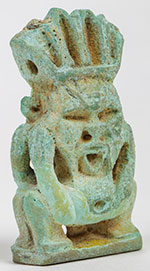 |
Egyptian Faience Bes Amulet. Late Period, Circa 700-300 BC. Pale green, matte surface faience, Janus-headed amulet of Bes, the Egyptian dwarf god who functioned primarily as a protector of mothers, children, and especially women during the treacherous process of childbirth. In this substantial figurine, designed to be worn as a pendant, the deity wears his typical feathered headdress and confrontational facial expression while grasping his pot belly and striking an akimbo stance. With his characteristically fierce attitude, this apotropaic divinity provokes the same disconcerting response today that he was intended to inspire at the time of his creation. Height: 2¾". Estimate Value $400 - 500
Ex Goldberg's Ancient and World Coins Auction of October 29-30, 2009, lot 806; Acquired from Emile Saad of Alexandria in the 1970s.
View details and enlarged photo
| Unsold |
Lot 2025 |
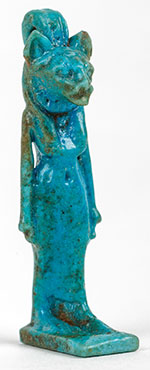 |
Egyptian Faience Amulet of the Lion Goddess, Sekhmet. 21st-26th Dynasty, Circa 1075-525 BC. This amuletic pendant depicts the ferocious goddess of war, Sekhmet. Standing with one foot advanced and arms at her sides, she appears as a lion-headed woman wearing a wig and a form-fitting sheath dress. Finely crafted and carefully detailed, with polished dark turquoise glaze. Perfectly intact and choice. Height: 1-9/16". Estimate Value $400 - 500
Ex Goldberg's Manuscripts and Collectibles Auction of April 30, 2005, lot 1770;Ex June 1986, Superior Galleries Sale of the bankrupt assets of the International Diamond Corporation. The ancient Roman glass was acquired thru Rafi Brown in the early 1980's.
View details and enlarged photo
| Realized
$324 |
Lot 2026 |
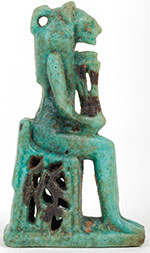 |
Egyptian Faience Enthroned Lion Goddess Amulet. Third Intermediate Period, Circa 1090-675 BC. This lion goddess, Sekhmet, sits on a throne with open work sides showing Nehebka and a uraeus. She has the head of a lioness with lappet wig and the body of a woman, her svelte figure accented by a form-fitting sheath dress. In one hand she holds a large sistrum. A sizeable amulet designed to be worn as a pendant. Intact and perfect, with overall green glaze and details highlighted with splashes of black. A choice example of this sought after amulet type. Height: 2-7/16".
Carol Andrews notes in her Amulets of Ancient Egypt, that this iconographic type can represent any number of goddesses, making it difficult to definitively assign a specific name to it. The presence of the sistrum may link it to older representations of Bastet, the cat goddess, and yet "…identical figures are identified as Sekhmet, the fierce goddess of the Memphite area, who symbolized the burning heat of the sun and, as the sun-god's vengeful eye, destroyed his enemies and brought plague and pestilence."Andrews illustrates two similar examples in figure 30, a & d. Estimate Value $1,500 - 2,000
Ex Goldberg's Manuscripts and Collectibles Auction of April 30, 2005;.
View details and enlarged photos
| Realized
$900 |
Lot 2027 |
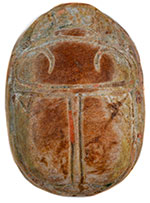 |
Egyptian Scarab Bearing the Cartouche of Pharaoh Amenhotep III. 18th Dynasty, Circa 1391-1353 BC. This delicate example of a scarab impression seal bears the throne name of Amenhotep III enclosed in the traditional oval cartouche. Husband to the unusually prominent Queen Tiye and father to the heretical Akhenaten (Amenhotep IV), Amenhotep III was, himself, a fascinating figure. The notion of the pharaoh's literal conception by Amen, the virtual chief of the Egyptian pantheon, in addition to the king's uniquely intimate relationship with the sun god, grew increasingly prominent during his reign, paving the way for the unprecedented, henotheistic ideology of his successor, who favored Aten, the sun god as the flaming disk in the sky, above all other deities. A wonderful souvenir of a remarkable historical moment, intact and in fine condition. Length: 5/8". Estimate Value $300 - 350
Ex Living Torah Museum collection; ex Archaeological Center Auction #29, lot 106.
View details and enlarged photos
| Realized
$252 |
Lot 2028 |
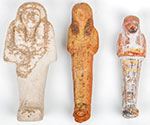 |
18th-21st Dynasty, Circa 1550-943 BC, Egyptian Ushabti Figures. Lot of three ushabti figurines originally deposited in private burials to be called upon as servants to the deceased tomb owner in the afterlife. 1. Limestone figure with surface details rendered in painted plaster, much of which has flaked away. Height: 7¼".
2. Sandstone figure with remnants of painted details and hieoglyphic inscription rendered in a vertical band along front of legs. Height: 7".
3. Terracotta figure with remnants of painted details and front panel of hieroglyphic text over legs. Height: 6¼". Estimate Value $1,000 - 1,500
Ex Goldberg's Ancient and World Coins Auction of October 29-30, 2009, lot 820.
View details and enlarged photo
| Realized
$1,293 |
Lot 2029 |
 |
Egyptian Scarab Bearing a Depiction of the Smiting Pharaoh. Reign of Senwosret III, Middle Kingdom, Circa 1878-1839. This steatite scarab impression seal is detailed with an image of the Pharaoh, wearing the Red Crown of Lower Egypt, smiting an Asiatic prisoner under the watchful eye of the god Horus, who appears here in falcon form. With a few chips to the rounded edges of the base, this delicate piece of history remains in very good condition. Length: 5/8". Estimate Value $200 - 250
Ex Living Torah Museum collection; ex Hixenbaugh Ancient Art; ex Ernest C. Freemark (1882-1966) collection, Elmore, Ohio, examined by J.H. Breasted in 1916.
View details and enlarged photos
| Realized
$192 |
Lot 2030 |
 |
Egyptian Pre-Dynastic Period, Circa 3600-3300 BC, Black-Topped Redware Vessel. This is an excellent example of black-topped redware pottery of the pre-dynastic Amratian (Naqada I) design. The handmade vessel stands on a small, circular base, with the body tapering outward to form a conical shape. The exterior is coated with a thin, red iron-oxide wash that was burnished to a lustrous finish. The black top is carbon, produced by subjecting the top of the vessel to dense smoke. Called B-ware by W.M. Flinders Petrie because of the distinctive black rims, black-topped pottery made of riverine clay is a hallmark of the Naqada Period. Intact, with some evidence of repair apparent on the interior. Height: 5½".
Cf. William Hayes, The Scepter of Egypt, A Background Study of the Egyptian Antiquities of the Metropolitan Museum of Art, Vol. 1, Fig. 7, p. 16; Cleveland Museum Catalogue of Egyptian Art, 1999, No. 48. Estimate Value $400 - 600
Ex Living Torah Museum collection, donated to the museum by Dr. Donald Brown.
View details and enlarged photo
| Realized
$456 |
Lot 2031 |
 |
Byzantine Period, 4th-6th century Bronze Hanging Incense Burner. Hexagonal-shaped vessel with straight walls and simply molded base and rim elevated on three decorative feet and with three loops attached at the rim for hanging. With passages of rusty red, violet, and green patina. In fine condition. Height: 2 3/4"; Width: 3 1/2".
Cf. Archaeological Center Auction No. 38, lot 307. Estimate Value $200 - 300
Ex Living Torah Museum collection.
View details and enlarged photo
| Realized
$132 |
Lot 2032 |
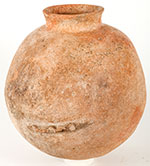 |
Judean Terra Cotta Storage Vessel, ca. 3200-2200 BC. Intact large storage vessel like this example in near choice condition. A minor 1¼ x ½" chip competently repaired to lip. Actual piece measures 11¾ x 10 x 10. Vessel comes with a custom wooden stand 17 x 16 x 16" and with two placards, one a description of the vessel which is attached, the other is a dedication to recipient by the Jewish Federation Council. Estimate Value $600 - 800
View details and enlarged photo
| Unsold |
Lot 2033 |
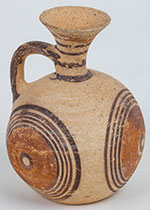 |
Judean Cyproit, Circa 700-475 BC., Terra Cotta Barrel Flask. In cream ware with red and brown geometric "bull's eyes" decoration around the body. Globular bottle with single strap handel and funnel flared mouth. Intact and in superb condition. Height: 4½"
Cf. Collecting Antiquities by Charles Ede, #100. Estimate Value $400 - 500
View details and enlarged photo
| Realized
$264 |
Lot 2034 |
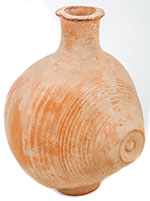 |
Cypriot, ca. 700-600 BC. Large Barrel-shaped Jug. Terracotta vessel with small, circular base, broad, barrel-shaped body, narrow, cylindrical neck, and slightly flaring rim. The surface of the pot bears ribs in concentric circles emanating from the right and left sides. Intact. Height: 8¼".
Cf. Fitchburg Art Museum, DSC08634. Estimate Value $400 - 500
Ex Living Torah Museum collection.
View details and enlarged photo
| Unsold |
Lot 2035 |
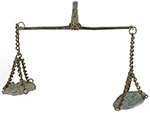 |
Roman Period Bronze Scale with Balance Beam. Bronze scale with weighing pans suspended by trios of chains from each end of the balance beam and fulcrum intact. Some damage to the outer edge of one of the weighing pans, but otherwise intact. Balance beam length: 5¾".
Cf. David Hendin, Ancient Scale and Weights, p. 53. Estimate Value $300 - 400
Ex Living Torah Museum collection.
View details and enlarged photo
| Realized
$600 |
Lot 2036 |
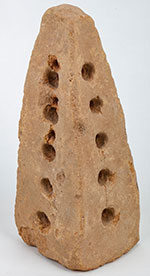 |
Roman Period Terracotta Toy Dovecote. A precise date of origin is uncertain. Fashioned of terracotta, this is a miniature version of the sort of columbaria, or dovecotes, used by the ancient Romans for housing pigeons or doves. As early as the Republican Period, similar structures, constructed underground, were adapted for the purpose of storing the cremated ashes of the deceased. Our example is four-sided, with square base narrowing toward the top, and one vertically oriented column of 5-8 perforations along each face of the structure. Intact, with just some minor chipping around the edges of the perforations. Height: 9". Estimate Value $300 - 400
Ex Living Torah Museum collection; ex David Liebert collection.
View details and enlarged photo
| Unsold |
Lot 2037 |
 |
Corinthian Stemmed Terracotta Dish, ca. 5th century BC. Shallow, wide-mouthed bowl set atop a modestly flared stem. Painted decoration in rusty orange and black appears on the interior around the circumference and around the tondo, and around the exterior below the rim. Surface wear and some light chipping, but still in fine condition. Height: 2 5/8"; Diameter: 6". Estimate Value $300 - 400
Ex Living Torah Museum collection; Ex Archaeological Center Auction No. 29, lot 361.
View details and enlarged photo
| Realized
$180 |
Lot 2038 |
 |
Egypto-Roman Period. Alexandria, circa 2nd-3rd century Terracotta Toy Fish. Fashioned of clay, this figurine takes the shape of a fish, with clearly defined head, fins, and scales. It is broken off near the tail and perforated through the head, perhaps to simulate a piercing caused by a hook, or to be worn as a pendant. Length: 2¼". Estimate Value $250 - 300
Ex Living Torah Museum collection.
View details and enlarged photo
| Unsold |
Lot 2039 |
 |
Roman Judaea. Terracotta Toy Wagon. Rectangular model wagon with hollowed interior. A perforation extending across the width of the base might accommodate an axel, though the function of a single piercing at one of the short sides remains uncertain. With one notable chip, about the size of a child's finger, along one side, otherwise intact. Size: 2 x 1½ x �". Estimate Value $200 - 250
Ex Living Torah Museum collection.
View details and enlarged photo
| Unsold |
Lot 2040 |
 |
Roman Period Terracotta Toy Flute. Simply made toy flute fashioned by hand with a long, cylindrical body and four applied buttons of clay to represent holes. Instrument is not functional, as the length of the flute is not hollowed out, nor are the finger holes actually perforated. Intact with just some minor chipping. Length: 6 7/8". Estimate Value $150 - 200
Ex Living Torah Museum collection.
View details and enlarged photo
| Unsold |
Lot 2041 |
 |
Roman, ca. 1st to 3rd century Large Silver Fibula. This handsome accessory, typically affixed at the shoulder to secure the woolen garments worn by the Romans, is a beautiful example of ancient metalwork. Intact and fully functional, it is in fine condition. Length: 2 3/8". Estimate Value $400 - 500
Ex Living Torah Museum collection; ex David Liebert Estate.
View details and enlarged photo
| Realized
$240 |
Lot 2042 |
 |
Roman Judaea, 1st Century AD. Unfinished Two-Handle Limestone Mug. In antiquity, stone vessels were primarily been used for grinding and pounding, and were carved from hard limestone or basalt. Vessels fashioned from white and bituminous chalk, a soft limestone, first appear during the Second Temple Period. Their creation seems to coincide with an increased strictness in the observance of the laws of purity and defilement in the Halakah, the entire body of Jewish law and tradition, including the laws of the Bible and the oral law as transcribed in the legal section of the Talmud. The core of this unfinished exemplar was never hollowed out. Height: 4 1/8".
Cf. Purity Broke Out in Israel: Stone Vessels in the Late Second Temple Period (University of Haifa, 1994), plates I-II. Estimate Value $250 - 300
Ex Living Torah Museum collection.
View details and enlarged photo
| Realized
$235 |
Lot 2043 |
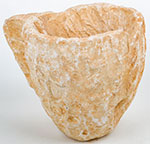 |
Roman Judaea, ca. 1st century AD. Unfinished Limestone Mug. In antiquity, stone vessels were primarily been used for grinding and pounding, and were carved from hard limestone or basalt. Vessels fashioned from white and bituminous chalk, a soft limestone, first appear during the Second Temple Period. Their creation seems to coincide with an increased strictness in the observance of the laws of purity and defilement in the Halakah, the entire body of Jewish law and tradition, including the laws of the Bible and the oral law as transcribed in the legal section of the Talmud. The core of this unfinished exemplar was never fully hollowed out. Height: 5½".
Cf. Purity Broke Out in Israel: Stone Vessels in the Late Second Temple Period (University of Haifa, 1994), plates I-II. Estimate Value $250 - 300
Ex Living Torah Museum collection.
View details and enlarged photo
| Realized
$141 |
Lot 2044 |
 |
Roman, ca. 2nd-3rd century Bronze Panther-form Handle. Cast bronze handle stylized to resemble a leaping feline, with its head high, legs outstretched, and body delicately attenuated to convey both grace and speed. Rear paws are fit into an integral loop, perhaps to facilitate hanging. Forepaws are missing. Smooth green patina with earthen encrustation. Accompanied by a custom metal base. Length: 5¼". Estimate Value $700 - 800
Ex Living Torah Museum collection; ex collection of Harlan Berk, Chicago.
View details and enlarged photo
| Unsold |
Lot 2045 |
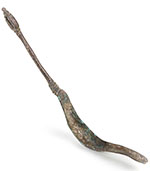 |
Greco-Roman Silver Strigil. Ca. 2rd century BC - 2nd century AD. Small, metal tools like this one were used by the ancient Greeks and Romans as part of a post-exercise cleansing regimen. After applying scented oil to the skin, a strigil was used to scrape the excess away, leaving the skin moisturized and perfumed. This fine example was likely formed using a combination of the lost-wax casting method and some hammering to achieve the proper shape to the curved blade. Decorative detailing at the end of the handle and juncture of handle and blade evinces a simple, elegant aesthetic. Intact and in very good condition. Length: 7¼".
Cf. Rhode Island School of Design Museum 15.142. Estimate Value $500 - 700
Ex Living Torah Museum collection.
View details and enlarged photo
| Realized
$306 |
Lot 2046 |
 |
Roman, ca. 2nd-3rd Century Carnelian Intaglio Ring Stone. Roman, Circa 2nd-3rd Century AD. Flat oval ring stone delicately carved of semi-transparent carnelian with the facing profile busts of Sol at left and Luna at right, the Roman god of the Sun and goddess of the Moon, respectively. The two figures are separated by a slender, vertically oriented branch. In excellent condition. Size: 17 mm x 14.5 mm.
Cf. Christie's Ancient Jewelry Auction of December 7, 2006, lot 273. Estimate Value $300 - 400
Ex Living Torah Museum collection.
View details and enlarged photo
| Realized
$312 |
Lot 2047 |
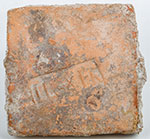 |
Roman Judaea. Terracotta Brick Bearing the Stamp of the Tenth Legion. Established in 41-40 BC by Julius Caesar's heir, Octavian, during his conflict with Pompey, but later stationed Syria and eventually transferred to Judaea, the Jewish historian Josephus records that the Tenth Legion (Legio X Fretensis), was among those responsible for the destruction of the Temple in Jerusalem under the leadership of the Roman general and future emperor, Titus. This brick bears the inscription LEG X FR, clearly identifying it as a brick made by this historically important unit of the Roman military. In excellent condition, with remnants of mortar still affixed around the perimeter of the brick. Size: 7½ x 7½" x 1¼". Estimate Value $500 - 700
Ex Living Torah Museum collection.
View details and enlarged photo
| Realized
$1,560 |
Lot 2048 |
 |
Roman, ca. 3rd century AD Silver Ring with Onyx Intaglio. Silver setting and band with stylized palm design framing central intaglio depicting a standing Victory. In very good condition. Ring size: 5½. Estimate Value $250 - 300
Ex Living Torah Museum collection; ex Tom Cederlind estate.
View details and enlarged photo
| Realized
$180 |
Lot 2049 |
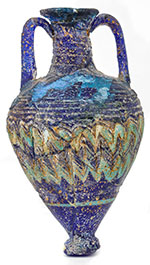 |
Phoenician, ca. 5th-4th century BC Core-Formed Glass Amphoriskos. Cobalt blue glass body with opaque yellow and turquoise threads spiraling around the body. Constricted base widens to conical body, rounded shoulder, narrow, cylindrical neck, and slightly flaring rim. Applied twin handles stretch from the base of the rim to the shoulder. With some chipping and repairs apparent, this remains a beautiful example of one of the earliest glass-making techniques. Height: 3 5/8".
Cf. Corning Museum of Glass, No. 50.1.3. Estimate Value $500 - 700
Ex Living Torah Museum collection.
View details and enlarged photo
| Realized
$480 |
Lot 2050 |
 |
Phoenician, 3rd-2nd Century BC. Sand Core Glass Alabastron. This early glass vessel has a straight-sided, fusiform body with convex, pointed base and small, circular mouth over a slightly rounded shoulder. Fashioned of deep cobalt blue glass, the surface bears an applied opaque white marvered thread which spirals around the entire length of the vessel, tooled into a festoon pattern over the body. Twin handles are applied near the top of the top of the body. Some chips at the rim, and repairs evident through the body. Height: 4½".
Cf. Christies Antiquites Auction No. 2856 of June 5, 2014, lot 42. Estimate Value $500 - 700
Ex Living Torah Museum collection.
View details and enlarged photo
| Unsold |
|
|